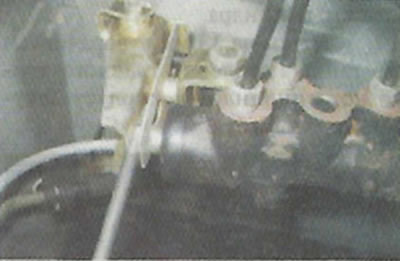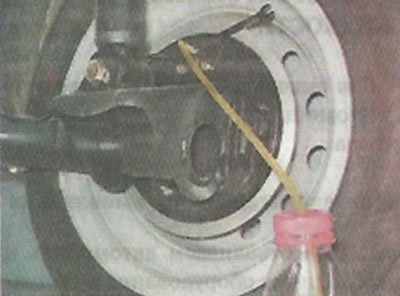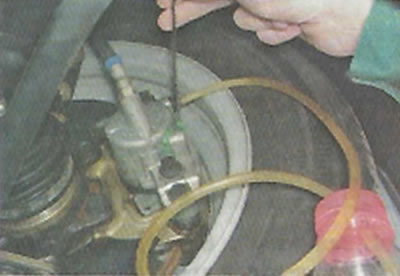You will need an assistant to complete the work, as well as:
- a special key for the bleed valve or an 8 mm ring spanner;
- transparent vinyl tube of suitable diameter;
- container for draining brake fluid;
- new brake fluid recommended by the manufacturer («Reference data»).
- manhole or overpass (desirable).
Execution sequence
1. We prepare the car for work («Preparing the car for maintenance and repair»).
2. Disconnect the wiring harness connector from the low brake fluid level sensor connector and remove the reservoir cap («Brake fluid low level sensor - check and replace»).
To prevent air from entering the hydraulic drive of the brake system, while pumping the drive, make sure that the level of brake fluid in the reservoir does not fall below the MIN·mark.
Warning! If the rear axle of the car is suspended (the vehicle is on a lift or on stands), the pressure regulator will block the path of the brake fluid to the rear wheel cylinders. Therefore, in order to bleed the rear wheel cylinders, it is necessary to open the regulator valve.
3. To open the pressure regulator valve, insert the blade of a slotted screwdriver between the lever and the plate, sinking the regulator stem.

4. We clean the fitting of the brake cylinder of the rear right wheel and the surface around it from dirt.
5. Remove the protective rubber cap from the bleed valve.
6. We put a special or 8 mm ring wrench on the bleed valve, and then a transparent vinyl tube (the diameter of the tube must be such that it fits snugly on the fitting). We lower the other end of the tube into a transparent container partially filled with brake fluid.

7. The assistant presses the brake pedal several times and, after the last pressing, holds the pedal in the lower position.
8. Having loosened the fitting, unscrew it approximately half a turn until the fluid starts to exit the fitting.
9. After the brake fluid stops coming out of the tube, we wrap the fitting.
10. The assistant again presses the pedal several times and keeps it pressed.
11. Repeat the steps described in paragraphs 7 and 8 (see above).
12. We carry out bleeding until the exit of brake fluid with air bubbles from the cylinder fitting stops, after which we finally tighten the fitting.
13. Remove the vinyl tube and the spanner from the fitting, put a protective rubber cap on the fitting.
14. Next, we pump the brake cylinder of the front left wheel.

15. Similarly, we pump the cylinders of the second circuit: the rear left and front right wheels in the indicated order, monitoring the fluid level in the reservoir of the main brake cylinder.
16. By pressing the brake pedal, we check the operation of the hydraulic drive and the absence of fluid leakage from the bleeder fittings. If the pedal «soft» or it falls below its normal operating position, we re-confirm the tightness of the system and repeat the pumping of the hydraulic drive.
